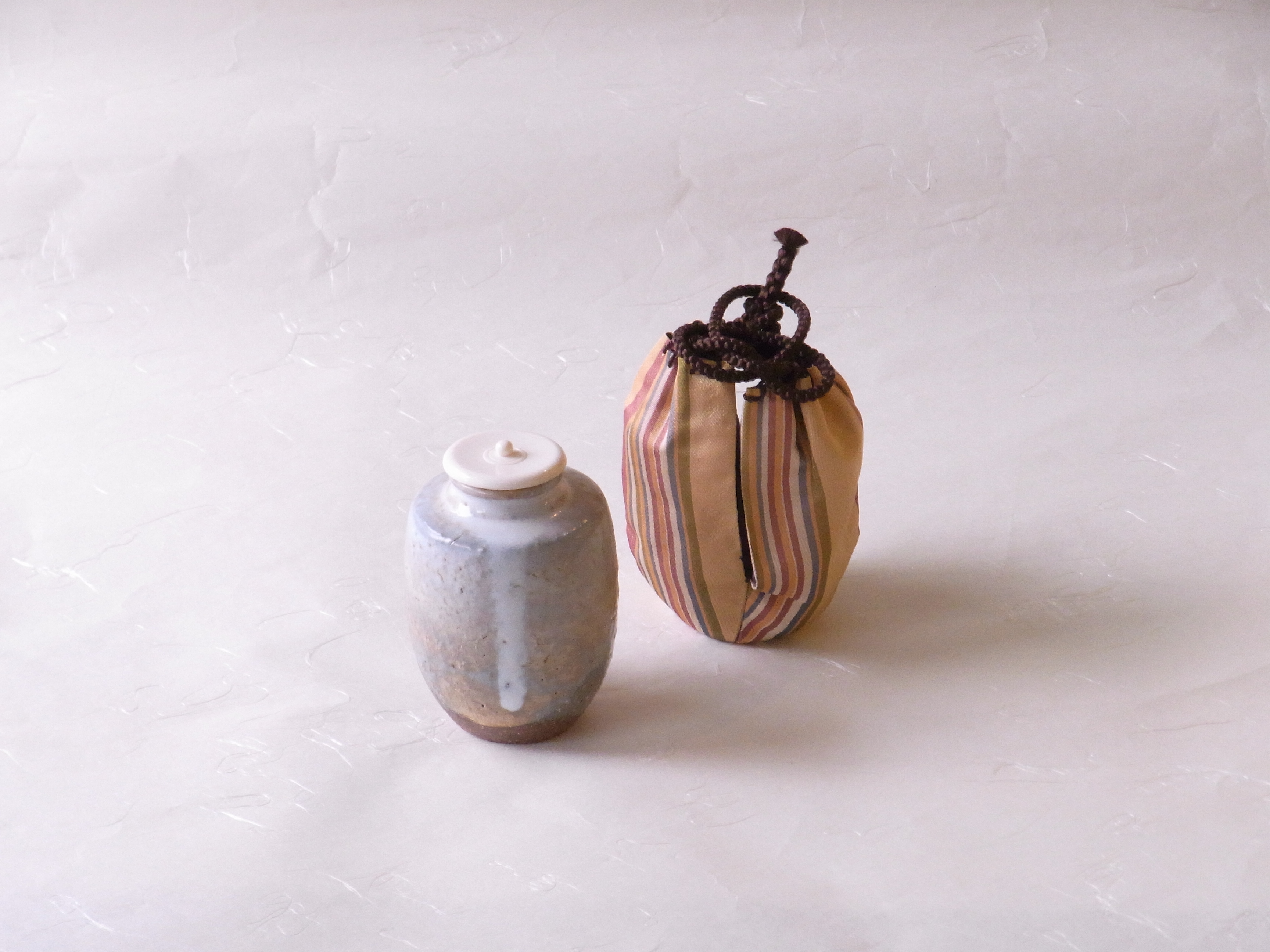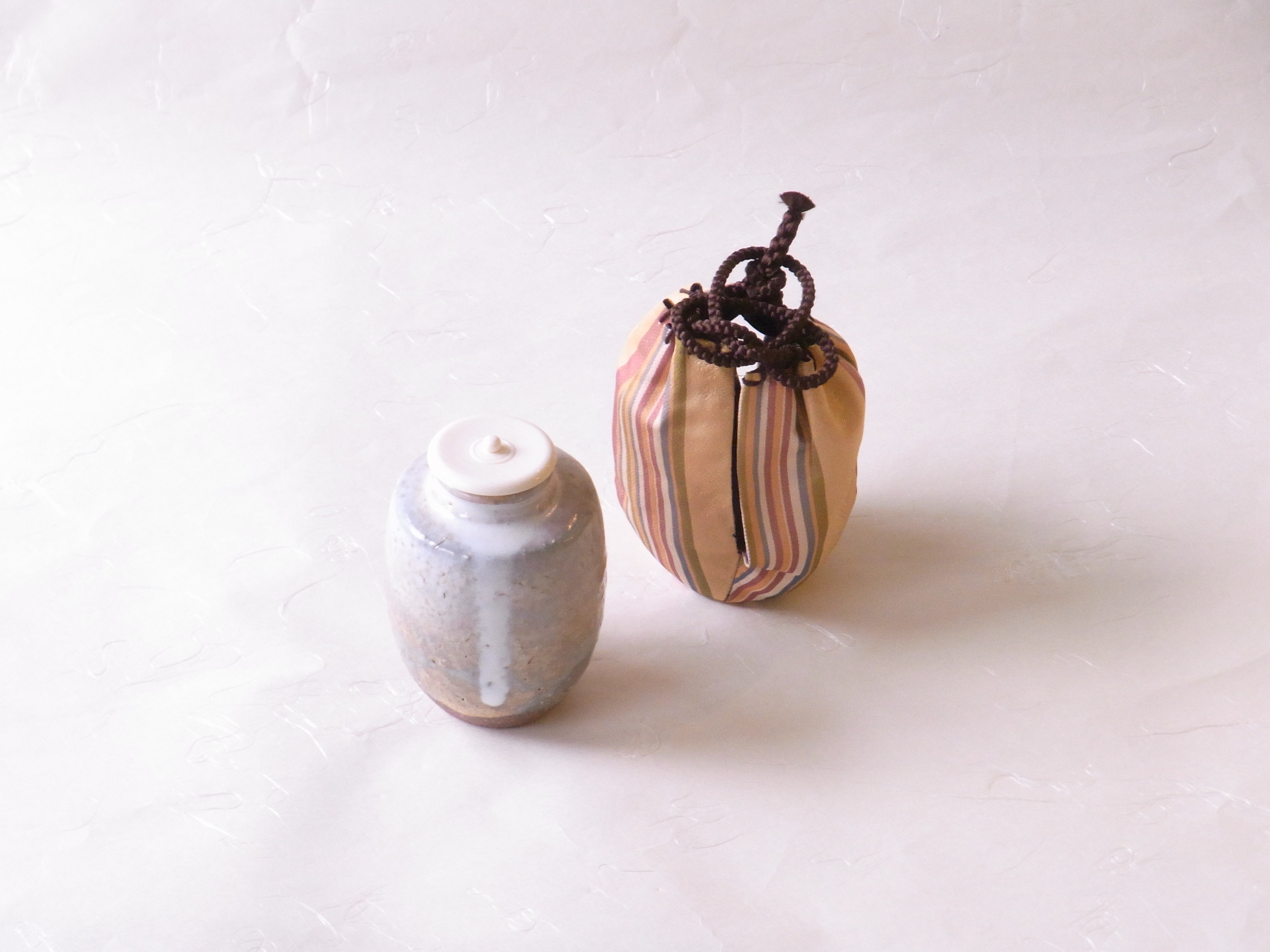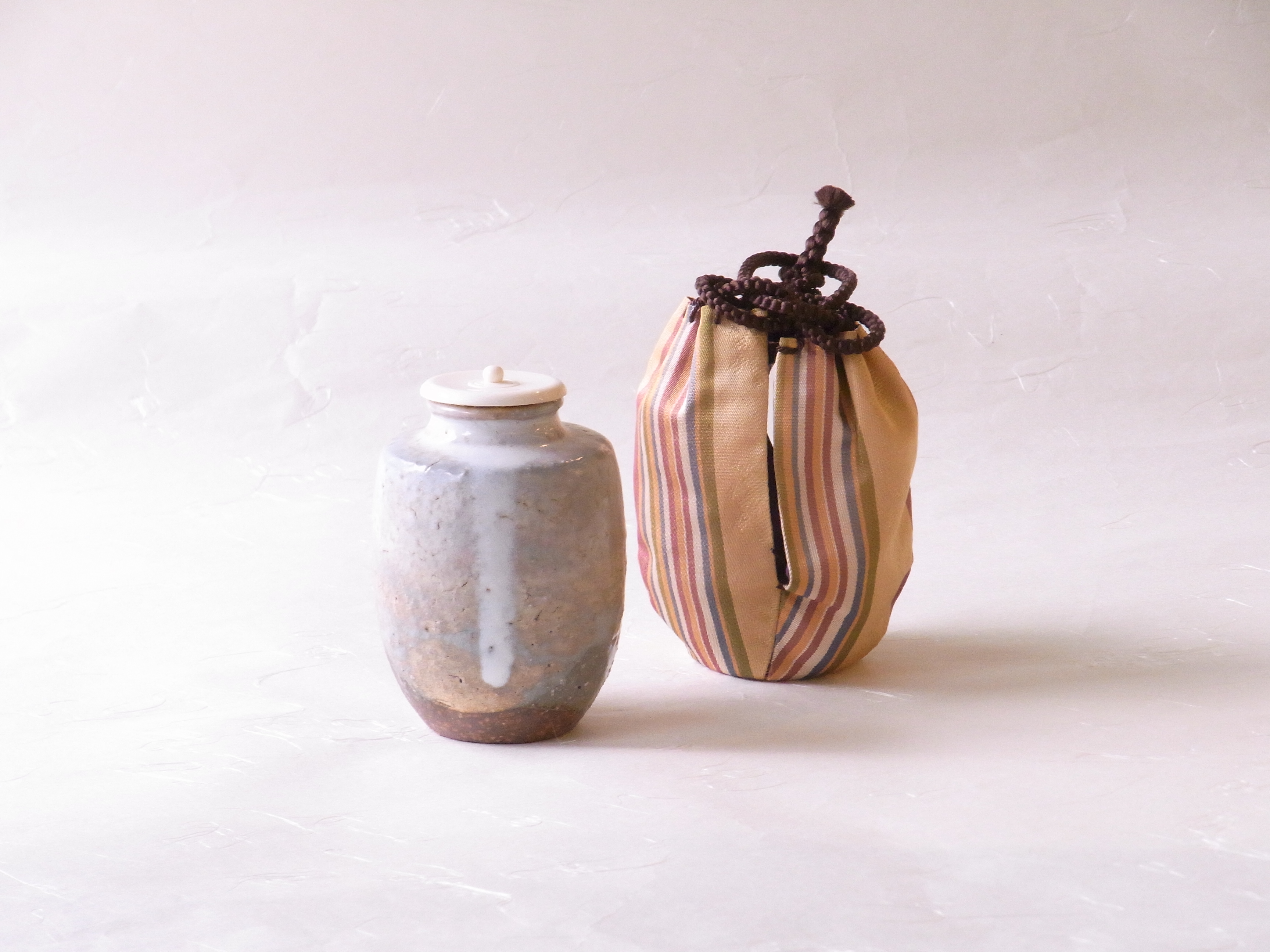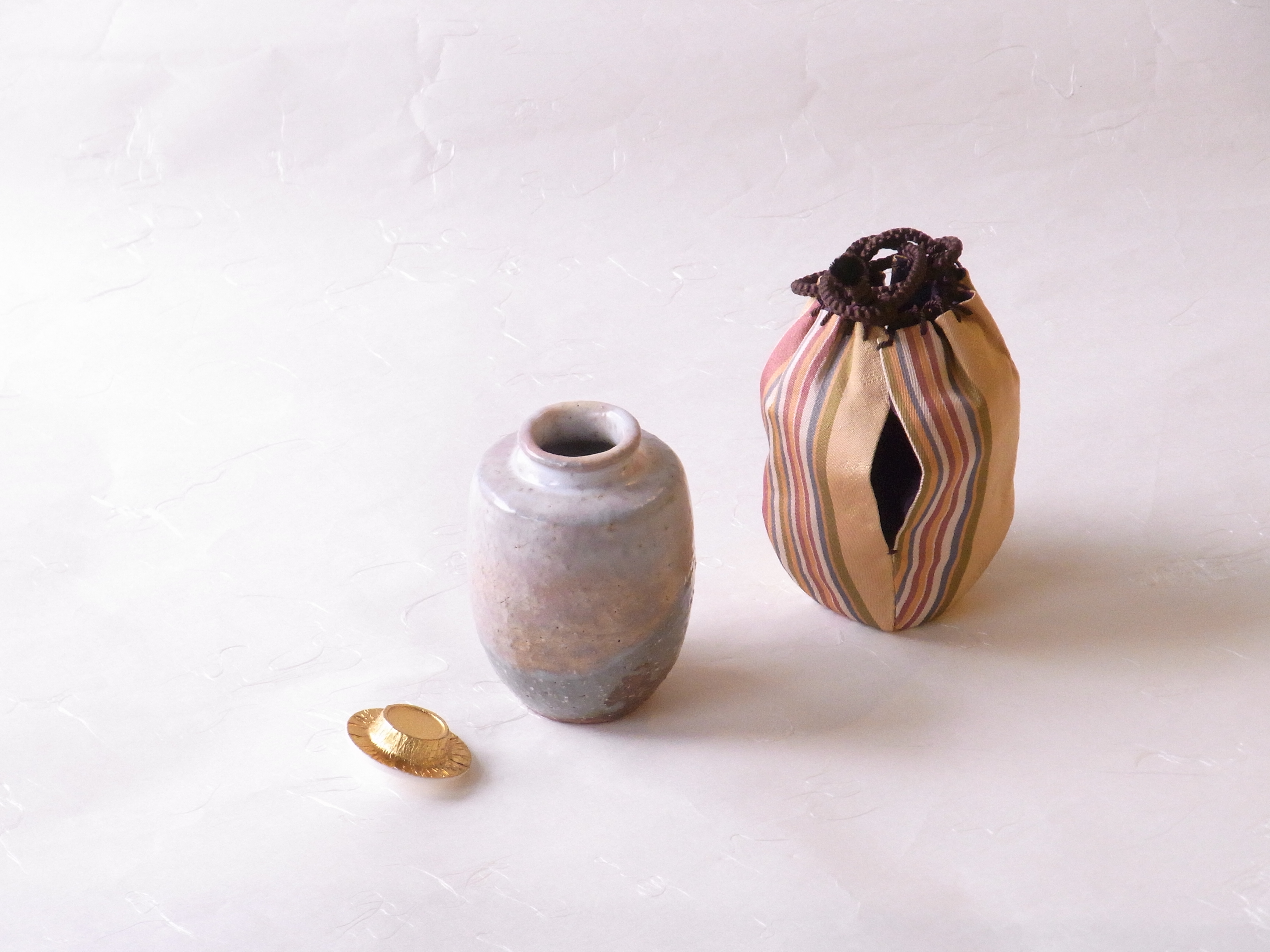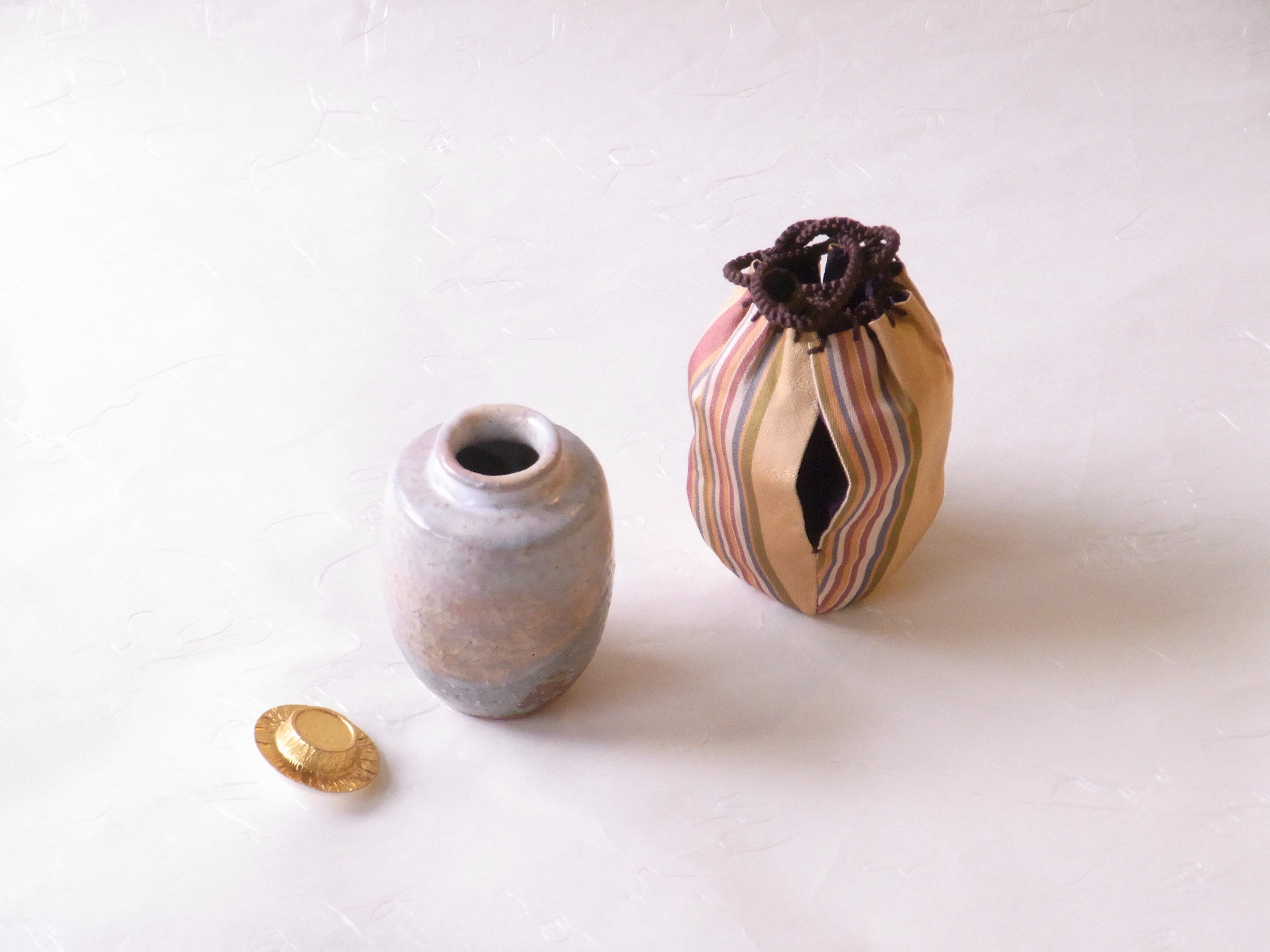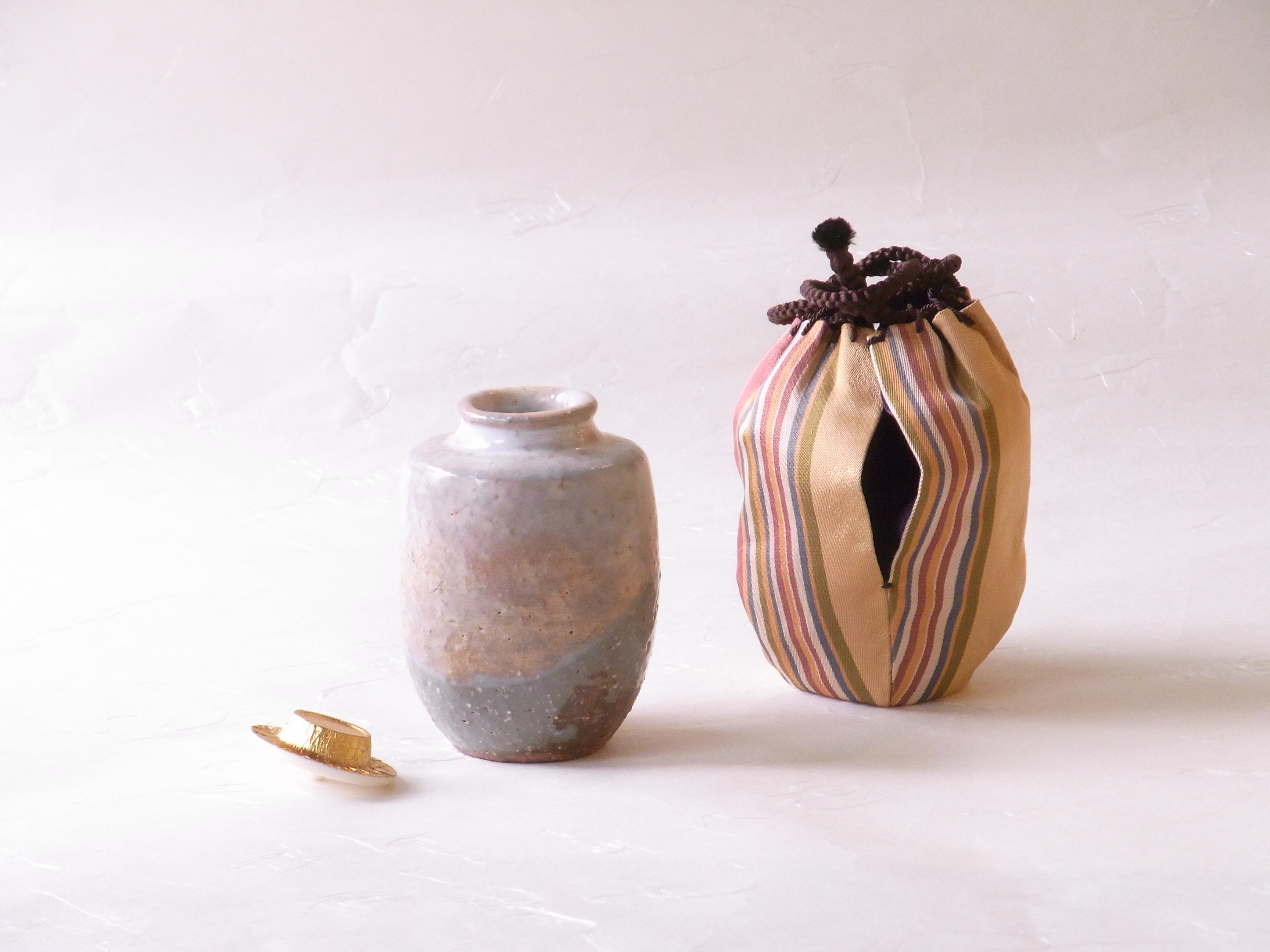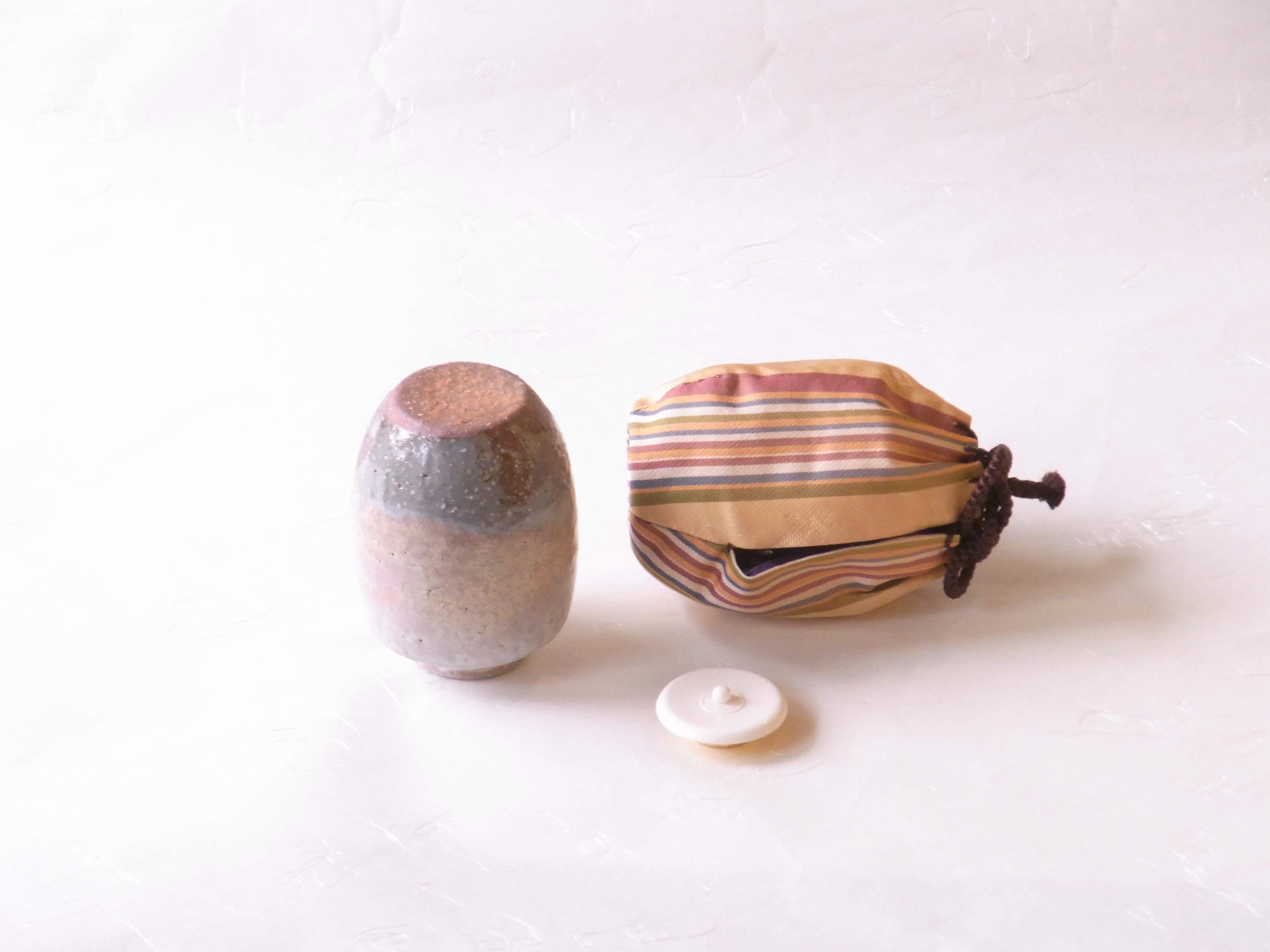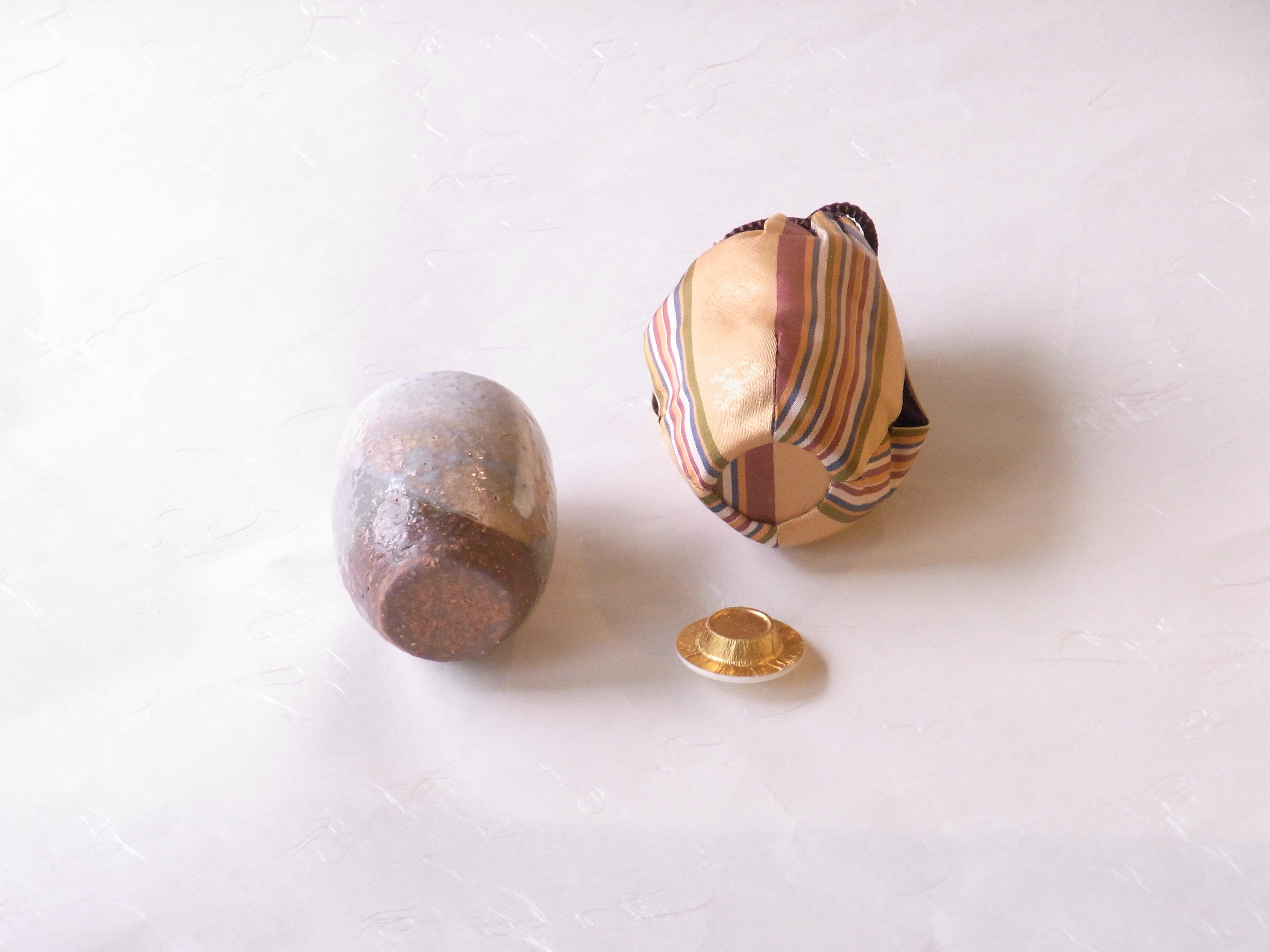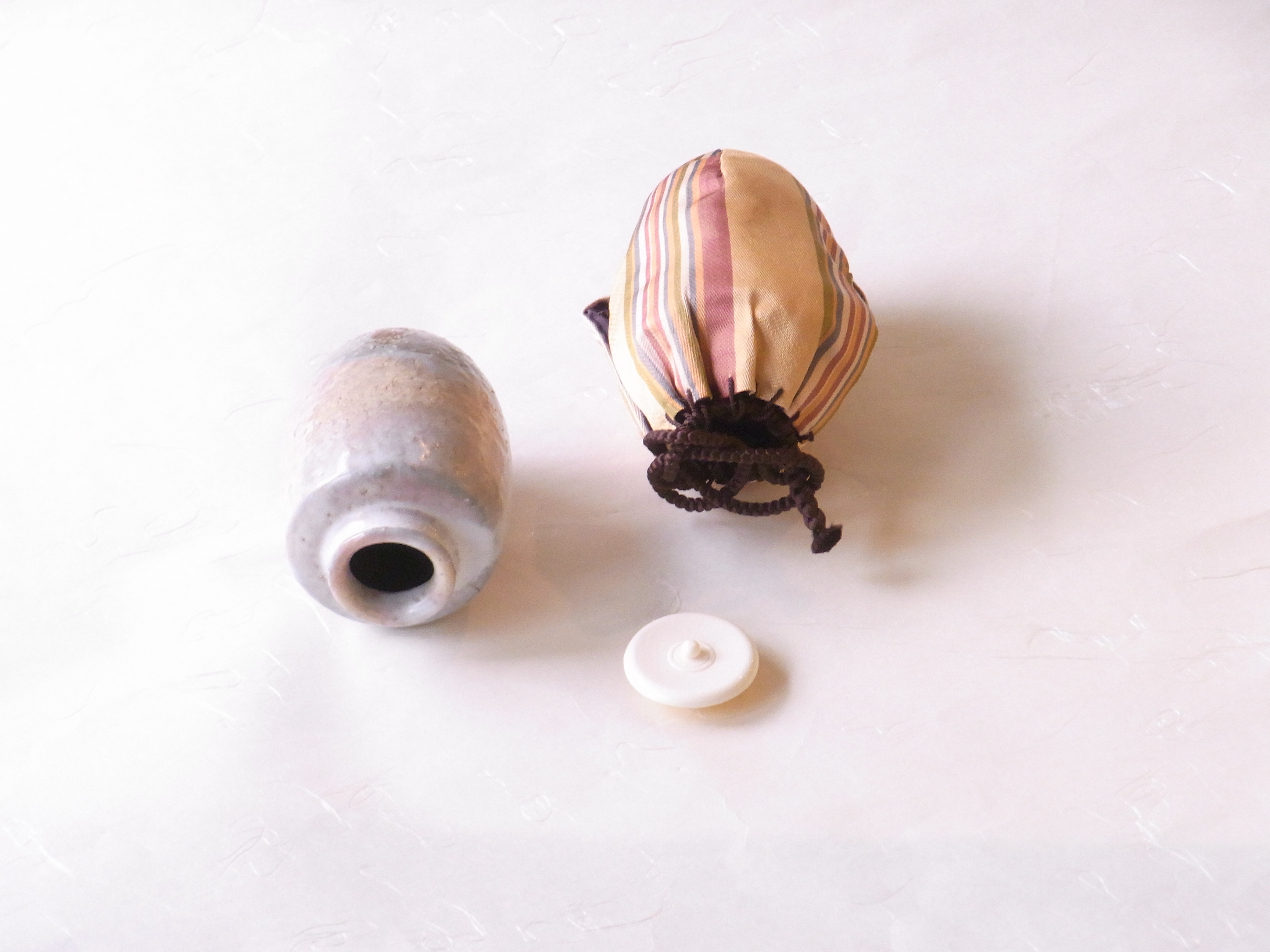林紅陽氏の肩衝き茶入れのご紹介です。
茶入れとは茶道で使う主に濃茶をいれる器で
象牙の蓋が付いて、仕服という茶入れを入れる裂地に入っています。
林紅陽氏は、萩焼では有名な作家で、この茶入れもよくできています。
この茶入れは全体に小さく、口造りや全体の造形も難易度が高く
茶入れがしっかりと作れる作家は技術が高いとされています。
上部から全体にかかっているのは、白い釉薬で正面には
白い釉薬の垂れが一本通っています。
胴あたりの中間部分は、萩焼らしい黄土色ですが、少し赤みがかっています。
下部は土そのものの濃い茶色とグレーの釉薬がかかっています。
様々な色が入り組んだ、複雑な風合いとなっています。
こげ茶色の土は粗く、全体にピンホールや表面のひびが所々に見られ
荒々しい、土味を感じて頂けます。
仕服の裂地も「名物裂」と言われる、特に珍重されたものを使う場合が
多くなっています。
「名物裂」とは鎌倉時代から江戸時代に渡来した、特定の染織もので
当時の茶人たちの見識で選ばれたもので、当時の所持者や伝来者の名が
付いたものや、地名や裂地の文様名が付いたものもあります。
この裂地は「俵屋金襴」と呼ばれ、薄い朽葉(くちば)色の地合いに、
茶 萌黄 黄 浅黄などの太、細の縦縞を繻子(しゅす)地で
織り出し、太縞の部分に龍紋を金糸と色糸で紋あげしている錦織の一種です。
俵屋は京都西陣の機屋(はたや)の名で、明朝様式の錦の織法を伝える
唐織を始めたと伝えられています。
胴径 6㎝ 高さ 9㎝
It is an introduction of Mr. Hayashi Hongyang’s shoulder-to-shoulder tea bowl.
A teacup is a bowl that mainly makes dark tea used in tea ceremony.
It has an ivory lid and is in a cleft area where you can put a teacup called a dress.
Mr. Lin Hongyang is a famous writer of shochu ware, and this tea bowl is well made.
This tea bowl is small throughout, and the difficulty of the mouth making and the whole modeling is high.
It is said that the artist who can make the tea bowl firmly has a high technology.
From the top to the whole, the front is covered with white glaze.
A drop of white glaze passes through.
The middle part of the body is ochre color which seems to be a skewer, but it is a little reddish.
The lower part is covered with dark brown and gray glaze of the soil itself.
It is a complex texture that various colors are complicated.
The dark brown soil is rough, and there are some pinholes and surface cracks throughout.
You can feel the rough, earthy taste.
The tear of the dress is also said to be a “specialty tear”, especially when using a rare thing
It is more and more.
“Specialty tear” is a specific dyeing and weaving that came from the Kamakura period to the Edo period.
It was chosen by the wisdom of the tea people at that time, the name of the possession and the visitor at that time
Some are attached, and some have place names and pattern names of rifts.
This rift is called “Kashiya Kinran”, and the ground of the thin decayed leaf (Kuchiba) color,
Tea, yellow, yellow, such as as a thick, fine vertical stripes in the gyoza
It is a kind of nishikori that weaves out and crests the dragon crest with gold thread and colored thread in the part of the thick stripe.
Tsuboya is the name of hataya in Nishijin, Kyoto, and conveys the Ming dynasty style of the weaving method of the mullet.
It is said that he started Karaori.
這是林紅陽先生肩上茶的介紹。
茶碗是茶道中主要用濃茶的容器。
象牙蓋被放在一個裂谷裡,把茶放在衣服上。
林紅陽先生是一位著名的作家,他非常有名將,他做的很好。
這個茶庫是小整個,和整個造型的口水是高難度
能夠製作茶杯的作家被認為是技術高的作家。
從頂部到整個前面與白色釉料
有一根白釉滴。
每個軀幹的中間部分是淡褐色,似乎燒焦,但有點紅。
底部是深棕色和灰色的土壤釉料。
各種顏色結合,已成為一個複雜的質地。
深棕色的土壤是粗糙的,針孔和表面的裂縫被看到整個地方
你可以感受到粗糙和土味。
衣服的撕裂被稱為”名品撕裂”,特別是當使用重物時
越來越多了
“傑作”是從倉倉時代到江戶時代傳入的某種染色編織物。
這是根據當時的茶人的洞察力選出的,當時擁有的人和繼承人的名字
有些是附加的,有些是地名和裂縫的圖案名稱。
這個裂谷被稱為”金角”,在薄葉的顏色上,
茶 黃 黃 淺黃色 等厚, 細分隔號紋在梯子
編織,它是一種編織,龍紋在大腿部分與金線和彩色線。
酒井法子是京都西津的機店,傳達了明朝風格的織造方法。
據報導,他已經開始做唐織。
这是林红阳先生肩上茶的介绍。
茶碗是茶道中主要用浓茶的容器。
象牙盖被放在一个裂谷里,把茶放在衣服上。
林红阳先生是一位著名的作家,他非常有名将,他做的很好。
这个茶库是小整个,和整个造型的口水是高难度
能够制作茶杯的作家被认为是技术高的作家。
从顶部到整个前面与白色釉料
有一根白釉滴。
每个躯干的中间部分是淡褐色,似乎烧焦,但有点红。
底部是深棕色和灰色的土壤釉料。
各种颜色结合,已成为一个复杂的质地。
深棕色的土壤是粗糙的,针孔和表面的裂缝被看到整个地方
你可以感受到粗糙和土味。
衣服的撕裂被称为”名品撕裂”,特别是当使用重物时
越来越多了
“杰作”是从仓仓时代到江户时代传入的某种染色编织物。
这是根据当时的茶人的洞察力选出的,当时拥有的人和继承人的名字
有些是附加的,有些是地名和裂缝的图案名称。
这个裂谷被称为”金角”,在薄叶的颜色上,
茶 黄 黄 浅黄色 等厚, 细垂直条纹在梯子
编织,它是一种编织,龙纹在大腿部分与金线和彩色线。
酒井法子是京都西津的机店,传达了明朝风格的织造方法。
据报道,他已经开始做唐织。
